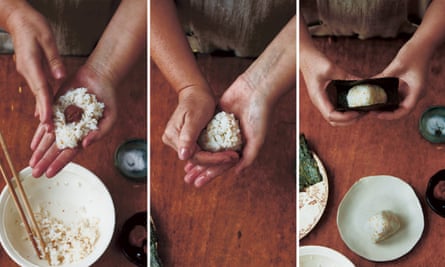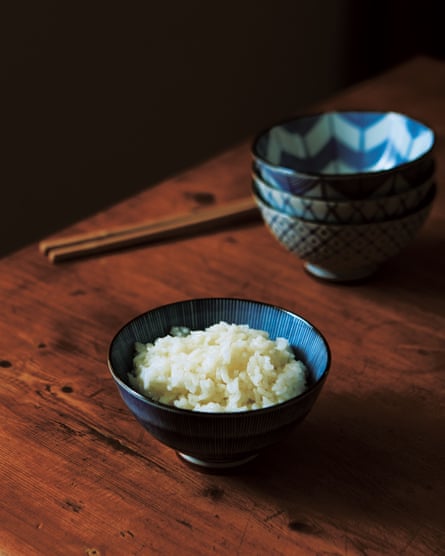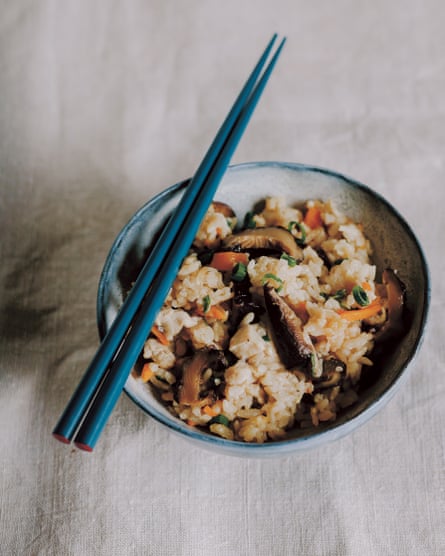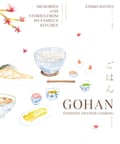
Sakedon (salmon donburi)
This donburi is quick to prepare – there is no cooking involved other than the rice, and you could put whatever ultra-fresh, sashimi-grade seafood you like on this. A good donburi has a sauce that flavours the rice underneath – you could also liberally drizzle it all over the dish or briefly marinate the salmon before assembling.
Serves 4
320–400g sushi-grade raw salmon or other seafood
4 large bowls freshly cooked Japanese short-grain rice (see recipe below)
1 sheet nori, snipped into thin strips with scissors
2–4 tbsp gari (pickled ginger)
Fresh green vegetables, such as thinly sliced cucumbers, avocado, blanched green beans, mustard greens, rocket or finely chopped chives, to serve
For the sauce
1 tbsp soy sauce
2 tsp mirin
A pinch of sugar
Finely slice the salmon against the grain into 3 to 5mm-thick slices. Arrange them on top of the bowls of warm rice along with the nori, pickled ginger and vegetables. Combine the sauce ingredients until the sugar is dissolved, then sprinkle it over the donburi and serve immediately.
Onigiri (filled rice balls)
One night, while up very late talking with my mother, we started making onigiri for a picnic the next day with the kids, her grandchildren. Onigiri is possibly the most perfect portable food or a snack on the run. I watched my mother shape the onigiri – she rubbed a pinch of salt on her hands so the rice wouldn’t stick, and cupped and pressed the rice, firmly but not too much.
Onigiri comes from the words o (お), meaning “giving honour” and nigiri (握り), “to grasp”. I remember being told that in the act of making onigiri, you transmit your love through your hands into the rice for the person you are making it for. That night, I was watching my mother do just that.
The rice is shaped into a little triangle that is seasoned with anything you want – it can even be left plain! My favourites are also classics: salmon, sesame and umeboshi (pickled plums). Even a little ball of tinned tuna mixed with some Japanese mayonnaise in the centre is very good. If you like, you can wrap nori around the onigiri so you don’t get your hands sticky when eating them. If you aren’t serving them immediately, pack the nori separately so that the seaweed will remain nice and crisp.
Makes 4
60g smoked salmon
Vegetable oil, for cooking (optional)
2 cups freshly cooked, still warm Japanese short-grain rice (see below)
1 spring onion, finely chopped
Salt, as needed
1 tbsp toasted sesame seeds
1 umeboshi (pickled plum), pitted and split in half
2 sheets nori, cut in half (optional)
Quickly cook the smoked salmon in a non-stick or lightly oiled pan until opaque, pale and almost crumbly, about three minutes. Place in a bowl and mix with half of the rice, along with the spring onion.
To make the salmon onigiri, with wet hands, take a pinch of salt and rub it over your hands. Pick up about half of the salmon-rice mixture and firmly cup in both of your hands to give it a firm triangle shape with no loose rice. Set down and repeat so that you have two salmon onigiri. If you find any rice is sticking to your hands, wet them again and rub another pinch of salt over your hands.
To make the umeboshi onigiri, stir the sesame seeds through the remaining rice until well distributed. Wet and salt your hands as before, take half of the sesame-rice and place half an umeboshi in the middle of the rice, then cup in your hands to shape into a triangle. Repeat with the remaining rice and umeboshi.
The onigiri can be enjoyed as they are, or placed in a bento box to be eaten later that day. You can also pack them with a piece of nori – split a large sheet in half so you have two long pieces about 10cm wide and use these to wrap around the whole onigiri.
Gohan (Japanese steamed rice)

Although my grandmother and mother have used an electric rice cooker for as long as I can remember, I have had to cook rice on the stove top ever since moving away for university – and I still do. This is, I find, the best way to replicate the soft, moist, sticky rice that comes out perfectly in an electric rice cooker. It is important to have a small, heavy-based saucepan or earthenware pot with a properly fitting lid, because the second part of the cooking process involves steaming and allowing the rice to finish cooking off the heat, covered.
Soaking the rice before cooking also helps but I can confirm you can make a decent pot of rice even when skipping this part. One thing you shouldn’t forget to do, though, is wash the rice two or three times before cooking. It should always be part of the ritual of cooking rice.
For perfect rice, just follow a simple ratio: for each portion of rice, use one and a half times the same volume in water. I generally use a quarter-cup measure per person, so a one-cup measure of rice for the family needs one and a half cups of water.
Serves 3–4 (Makes about 400g cooked rice)
200g Japanese short-grain rice (1 cup)
375ml cool water (1½ cups)
Place the rice in a small, deep, heavy-based pan with a tight-fitting lid.
after newsletter promotion
Fill with cool water and wash the rice, swirling it with your hand several times. Drain, then repeat the washing two to three more times. Ideally, let it soak for 30 minutes at this point.
Drain the rice and re-fill the saucepan with the measured cool, fresh water. Set over a low–medium heat on your smallest hob, bring to a simmer, then turn the heat down to the lowest setting, cover with the lid and cook for about 10 to 12 minutes, or up to 15 minutes.
Try to avoid lifting the lid for a peek – this will let out much of the desired steam. A well-trained ear can hear when the water has been almost completely absorbed but do keep an eye on it if it is your first time trying this method. At the slightest hint of the rice burning or the water evaporating too quickly, take it off the heat and let it finish cooking by steaming. If you taste the rice at this point it should be just very slightly al dente, still quite moist but not mushy.
Turn off the heat, keep the lid on and leave to steam for 10 minutes. Fluff the warm rice with a rice paddle and serve immediately.
Takikokomigohan (Shiitake and chicken rice)

I absolutely love this way of cooking rice, where you simply put all the ingredients into the one pot so the rice absorbs all the flavours and the chicken becomes incredibly tender.
Literally meaning “cooked with rice”, you can actually put anything you like in this – it is usually a dish where you might find many autumnal vegetables like mushrooms and chestnuts, as it’s a favourite to make with shinmai (new season rice), which is harvested in the autumn.
Although I find it hard to go past this classic shiitake and chicken combination, you could use aburaage (fried beancurd), bamboo shoots, clams or gobo (burdock root – although it can be hard to find outside of Japan). For a bit of richness, add a knob of butter before mixing it all together.
You will need to begin this recipe an hour ahead to soak the shiitake mushrooms and kombu, and marinate the chicken.
Serves 4
4 dried shiitake mushrooms
1 × 5cm square piece of kombu
250ml water (1 cup)
2 chicken thigh fillets, cut into bite-sized pieces
1 tbsp soy sauce
1 tbsp mirin
1 tbsp sake
1 tbsp minced ginger
230g Japanese short-grain rice (generous 1 cup)
½ carrot, peeled and cut into matchsticks
1 spring onion, green parts finely chopped
Soak the mushrooms and kombu for at least one hour in the water. (This will make a delicious shiitake dashi for the rice to cook in.)
While the mushrooms are soaking, marinate the chicken. In a small bowl, combine the soy sauce, mirin, sake and ginger. Pour the marinade over the chicken, then cover and refrigerate for one hour.
After an hour, remove the kombu and shiitake mushroons. Reserve the liquid – this is your shiitake dashi. Discard the kombu. Remove the stems from the shiitake and discard. Finely slice the shiitake caps and set aside.

Wash and drain the rice two or three times. Drain it very well the last time, then place the rice in a medium heavy-based saucepan with a tight-fitting lid.
The key to this dish is in the layering. Arrange the carrot on top of the rice, followed by the chicken pieces, the marinade, then the mushrooms and shiitake dashi. Cover with the lid, bring to the boil, then reduce the heat to very low and cook for 15 to 17 minutes, or until the liquid has all been absorbed (do not stir or touch the rice or ingredients). Let it rest, lid on, for a further 15 minutes to finish steaming.
To serve, toss everything together in the pot and sprinkle over the chopped spring onion.


